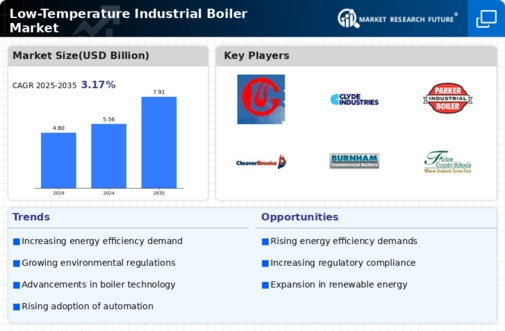Market Growth Projections
The Global Low-Temperature Industrial Boiler Market Industry is projected to experience robust growth over the coming years. With a market value expected to reach 5.56 USD Billion in 2024 and 7.91 USD Billion by 2035, the industry is on a promising trajectory. The anticipated compound annual growth rate of 3.25% from 2025 to 2035 indicates a steady expansion, driven by various factors such as technological advancements, regulatory support, and increasing industrialization in emerging markets. These projections highlight the potential for investment and development within the low-temperature boiler sector, suggesting a dynamic future for the industry.
Increased Focus on Sustainability
The Global Low-Temperature Industrial Boiler Market Industry is witnessing an increased focus on sustainability as industries strive to minimize their environmental impact. Companies are actively seeking solutions that not only meet operational needs but also align with sustainability goals. Low-temperature boilers, which utilize less energy and produce fewer emissions, are becoming a preferred choice for many sectors. This shift towards sustainable practices is likely to propel the market forward, as organizations recognize the long-term benefits of investing in eco-friendly technologies. The growing awareness of climate change and resource conservation further underscores the importance of adopting low-temperature boiler systems.
Growing Demand for Energy Efficiency
The Global Low-Temperature Industrial Boiler Market Industry experiences a notable increase in demand for energy-efficient solutions. Industries are increasingly seeking to reduce operational costs and carbon footprints, leading to a shift towards low-temperature boilers. These systems operate at lower temperatures, which enhances efficiency and minimizes energy consumption. As a result, the market is projected to reach 5.56 USD Billion in 2024, reflecting a growing trend among manufacturers to innovate and develop energy-efficient technologies. This shift not only aligns with global sustainability goals but also meets regulatory requirements, further driving market growth.
Regulatory Support for Emission Reduction
The Global Low-Temperature Industrial Boiler Market Industry benefits from stringent regulations aimed at reducing greenhouse gas emissions. Governments worldwide are implementing policies that encourage the adoption of cleaner technologies, including low-temperature boilers. These regulations often provide incentives for industries to transition from traditional high-emission systems to more environmentally friendly alternatives. As industries comply with these regulations, the demand for low-temperature boilers is likely to increase, contributing to the market's projected growth to 7.91 USD Billion by 2035. This regulatory landscape not only fosters innovation but also enhances the overall competitiveness of the industry.
Technological Advancements in Boiler Design
Technological advancements play a crucial role in shaping the Global Low-Temperature Industrial Boiler Market Industry. Innovations in boiler design, materials, and control systems are enhancing the performance and reliability of low-temperature boilers. For instance, the integration of smart technologies allows for better monitoring and control of boiler operations, leading to improved efficiency and reduced downtime. These advancements are likely to attract more industries to adopt low-temperature solutions, thereby expanding the market. As the industry evolves, the anticipated compound annual growth rate of 3.25% from 2025 to 2035 indicates a robust trajectory for technological integration in boiler systems.
Rising Industrialization in Emerging Economies
The Global Low-Temperature Industrial Boiler Market Industry is significantly influenced by the rising industrialization in emerging economies. As these nations expand their manufacturing capabilities, the demand for efficient heating solutions, including low-temperature boilers, is on the rise. Industries such as food processing, textiles, and pharmaceuticals are increasingly adopting these systems to enhance productivity while adhering to environmental standards. This trend is expected to drive market growth, with projections indicating a substantial increase in market value as industrial activities ramp up. The focus on sustainable practices in these regions further supports the adoption of low-temperature technologies.




















Leave a Comment